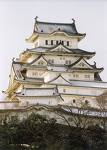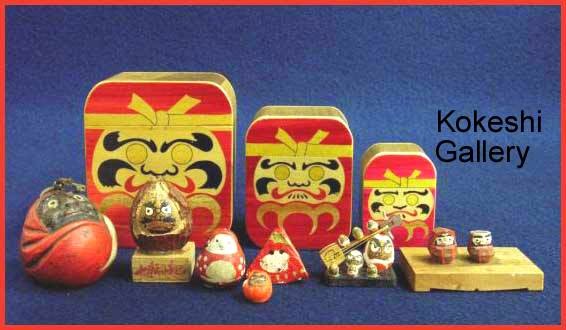:::::::::::::::::::::::::::::::::::::::::::::::::::::::::::::::::::::::::::::::::::::::::::::::::::::
Dolls from Kasukabe (Kasukabe hariko)
春日部張子 ?Kusagabe
Saitama prefecture

Fudo Myoo Oo 不動明王 Fudo Myo-O
. My Kasukabe Doll Collection .
Until Kintaro 金太郎
.......................................................................

source : www.kongohin.or.jp
Fudo from Igarashi san 五十嵐さん
. Mask of Fudo Myo-O / Kasugabe, Igarashi san

A traditional way to make dolls, passed down in the family of Igarashi san.
五十嵐健二
. Fudo Myo-O 不動明王 Acala Vidyârâja - Introduction.
:::::::::::::::::::::::::::::::::::::::::::::::::::::::::::::::::::::::::::::::::::::::::::::::::::::

Laughing Daruma Mask
(and more masks, click on the photo)
:::::::::::::::::::::::::::::::::::::::::::::::::::::::::::::::::::::::::::::::::::::::::::::::::::::
There is also Momotaroo, Kintaroo and many others.
桃太郎、金太郎などもあります。

Momotaro masks with the three animals.

Kintaro, the Strong Boy
:::::::::::::::::::::::::::::::::::::::::::::::::::::::::::::::::::::::::::::::::::::::::::::::::::::
Kasukabe 春日部
is a small town in Saitama prefecture. It is famous for its folk craft, especially for traditional chests of Paulownia wood and toys for the New Year (hagoita 羽子板). The papermachee dolls are another speciality of this town.
Kasukabe Daruma is made in the tradition of the Musashino (Bushu 武州) papermachee dolls. In this area it is easy to get traditional Japanese paper and under the influence of Takasaki the production of Daruma goes back to the Meiji Restauration (1868). Many producers of Daruma have found their own style and expression for a Daruma face, but it takes an expert to recognize all these differences. Eyebrows and beard are not so strongly painted as in the Takasaki Daruma dolls and the Chinese characters FUKU IRI for bringing in Good Luck 福入 are painted on the belly.
. . . CLICK here for Photos of Kasukabe Dolls!
. Folk Toys from Saitama .
:::::::::::::::::::::::::::::::::::::::::::::::::::::::::::::::::::::::::::::::::::::::::::::::::::::
Igarashi Kenji 五十嵐健二

Igarashi san is in the second generation producing toys of papermachee (hariko) who works in the tradition of Goseki Hariko 五関の張子 and his repertoire contains more than 100 different types of dolls. He produces many humorous Darumas of different features (henkei Daruma 変形だるま) taking hints from historical figures, like Momotaro, Kintaro and Urashima Taro.
There are also composite figures of Daruma on a wild boar, Daruma holding Fukusuke, Daikoku or Okame, Daruma as a Goblin and many others.

Daruma on a namazu catfish fish
ナマズの上に達磨
. Namazu なまず / 鯰 catfish legends and toys .
. Urashima Taro 浦島太郎 .
:::::::::::::::::::::::::::::::::::::::::::::::::::::::::::::::::::::::::::::::::::::::::::::::::::::

Dice with MONEY and a Futokoro Daruma
ふところだるま
to put in your purse for good luck
:::::::::::::::::::::::::::::::::::::::::::::::::::::::::::::::::::::::::::::::::::::::::::::::::::::

Beckoning Cat and Kintaro
source : 春日部張子 Kasugabe Hariko
:::::::::::::::::::::::::::::::::::::::::::::::::::::::::::::::::::::::::::::::::::::::::::::::::::::
Daruma on a wild boar
Year of the Wild Boar
Kasugabe Hariko 春日部張子


Inoshishi 猪 Wild Boar Papermachee Dolls
:::::::::::::::::::::::::::::::::::::::::::::::::::::::::::::::::::::::::::::::::::::::::::::::::::::

Watoonai 和唐内 / 和藤内 Watonai
Watonai is a figure of the Chinese legend of early Ming dynasty.
This young boy is famous for his physical strenth, even subduing wild beasts. Usually he is depicted with a tiger. He becme famous in Japan since Chikamatsu Monzaemon wrote a Puppet Theater Play (bunraku) about him.
. . . CLICK here for Bunraku Photos !
鄭成功(ていせいこう) Teisei Koo [1624~1662]
The model for Watonai.
. Watonai (Koxinga) 和唐内 / 和藤内 and Tiger Toys .
:::::::::::::::::::::::::::::::::::::::::::::::::::::::::::::::::::::::::::::::::::::::::::::::::::::
. Kasukabe Oshi-e Hagoita 羽子板
. The Momotaro Legend 桃太郎 Peach Boy
. The Kintaro Legend 金太郎 The Strong Boy Kintaro
. Folk Toys with Fish .
:::::::::::::::::::::::::::::::::::::::::::::::::::::::::::::::::::::::::::::::::::::::::::::::::::::::::::::::::::::::::::
[ . BACK to DARUMA MUSEUM TOP . ]
[ . BACK to WORLDKIGO . TOP . ]
- #kasugabe #watonai -
:::::::::::::::::::::::::::::::::::::::::::::::::::::::::::::::::::::::::::::::::::::::::::::::::::::::::::::::::::::::::::
















